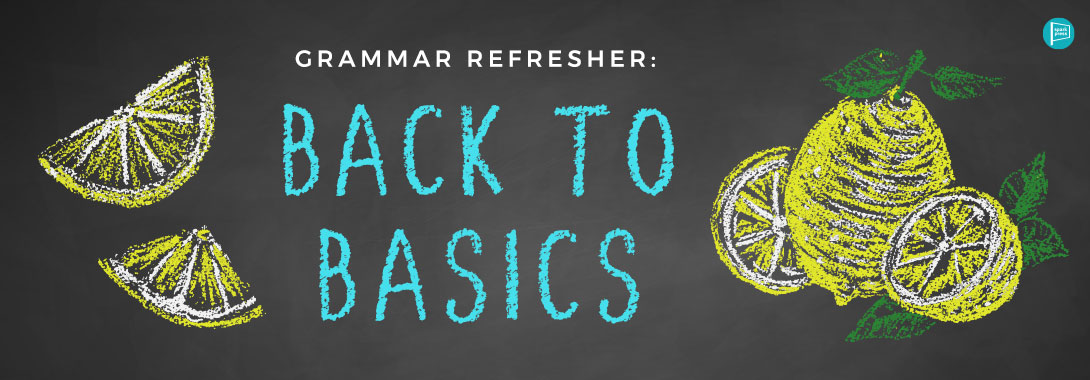
What even makes up a sentence? In our last grammar refresher, we talked about how to construct a sentence and focused on passive voice, different phrasing, and some punctuation marks. Now, we’ll break down a sentence even further to its different parts. Knowing what makes up a sentence, at the most basic level, will help you better understand your writing and how to constantly improve!
Subject
Every sentence has a “doer,” or a person, place or thing that is performing an action. This is the subject of the sentence, which is typically a noun or pronoun. It can also have a modifier (typically “the,” “a,” or “an”) or descriptive adjectives that precede the subject.
The firefighter drove the truck for his team.
Shawn learned how to drive at a very young age.
The fog covered the pier in the early hours of the morning.
Predicate
Accompanying the subject is the predicate: a verb expressing action or being within a sentence. Like the subject, a predicate can stand alone or have adverbs that modify it.
The firefighter drove the truck for his team.
The cat moved slowly throughout the house.
When the clock struck 5:00 p.m., the entire office gathered their belongings to go home.
Direct Object
The direct object receives the action of the sentence, or in other words, answers the “What?” of the sentence. Also, it is typically a noun or pronoun.
The firefighter drove the truck for his team.
The dog ate a treat.
The fisherman caught a large fish during his last fishing trip.
Indirect Object
An indirect object answers the question “to whom” or “for whom” the action is being done. Usually a noun or pronoun, the indirect object gives context to the action and indicates who the action is being done for.
The firefighter drove the truck for his team.
Adam gave his sister a present for her birthday.
The teacher taught her students multiplication tables.
Subject Compliment
A noun, pronoun, or adjective can be used as a subject compliment to describe or rename the subject. Subject compliments follow a linking verb, which is typically a form of the verb “to be.”
The firefighter is a courageous man.
The speaker was too quiet for the audience to hear.
My sister is an independent woman.
Lastly, a Quick Run Down of the Eight Parts of Speech!
Noun
A noun is a person, place, thing, or idea.
Wow! The large elephant raised its trunk slowly, but quickly sprayed us with water.
Pronoun
A pronoun is a word that takes place of a noun, in order to avoid repetition. There are many different types of pronouns, but the most common are personal pronouns and possessive pronouns.
Sarah told Alex that Sarah would give Sarah’s brother the card after school.
Compared to…
Sarah told Alex that she would give her brother the card after school.
Wow! The large elephant raised its trunk slowly, but quickly sprayed us with water.
Verb
A verb expresses action or being.
Wow! The large elephant raised its trunk slowly, but quickly sprayed us with water.
Adjective
An adjective describes or modifies a noun or pronoun.
Wow! The large elephant raised its trunk slowly, but quickly sprayed us with water.
Adverb
An adverb describes or modifies a verb, adjective, or another adverb.
Wow! The large elephant raised its trunk slowly, but quickly sprayed us with water.
Preposition
A preposition is placed before a noun or pronoun to show a relationship. Prepositions are used to describe a relationship between words in a sentence and answer the questions “where,” “when,” or “how.”
Wow! The large elephant raised its trunk slowly, but quickly sprayed us with water.
Some common prepositions are: in, on, of, for, above, below, according to, etc.
Interjection
An interjection is a word used to express emotion and is typically followed by an exclamation point.
Wow! The large elephant raised its trunk slowly, but quickly sprayed us with water.
Conjunction
A conjunction joins words, phrases, or clauses within a sentence and indicates the relationship between those words. There are two types of conjunctions, coordinating and subordinating. Coordinating conjunctions connect two independent clauses, while subordinating conjunctions connect an independent clause with a dependent clause. The coordinating conjunctions form the acronym FANBOYS (for, and, nor, but, or, yet, so). Subordinating conjunctions include after, although, because, during, once, and many more.
Wow! The large elephant raised its trunk slowly but quickly sprayed us with water.
Independent Clause
An independent clause is a group of words that can stand on its own as a sentence. An independent clause has a subject and a predicate and it does not require any additional information to make sense. You can combine two independent clauses with a comma and coordinating conjunction as described above. Alternatively, you can join them with a semicolon.
Amy focused on packing the luggage for the trip, and Adam worked on booking the flights.
Dependent Clause
A dependent clause, however, cannot stand on its own and needs an independent clause to make sense. In other words, it begins a thought without finishing it, causing readers to be confused and left hanging. Using a subordinate conjunction, you can combine a dependent clause with an independent clause and create a strong sentence.
After leaving the office, Steven found himself stuck in rush hour traffic.
Amanda ended up forgetting her speech even though she had practiced many times.

Leave A Comment